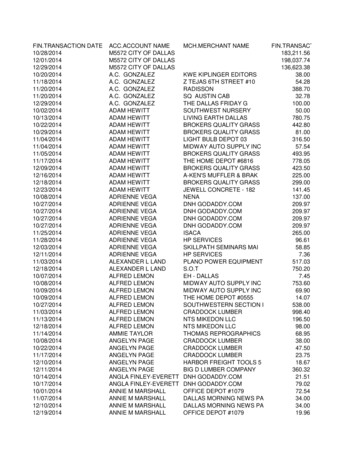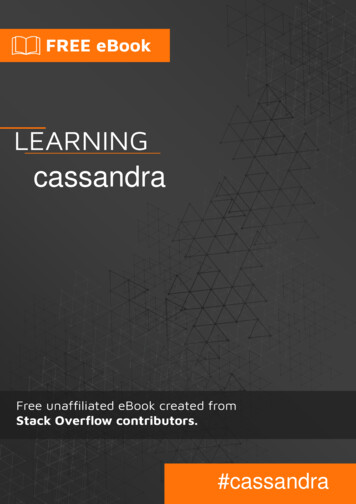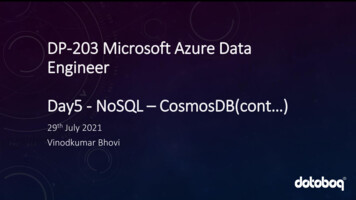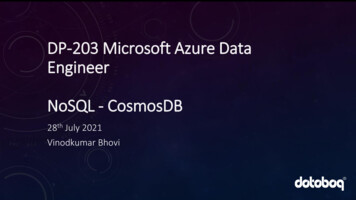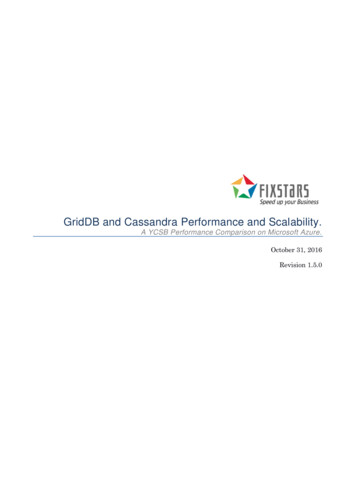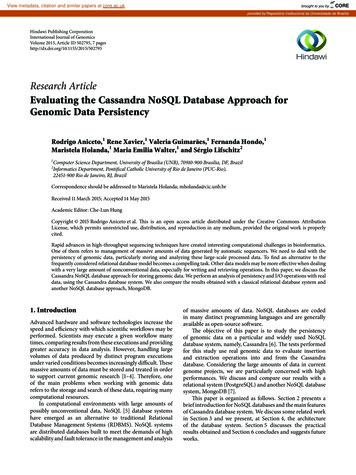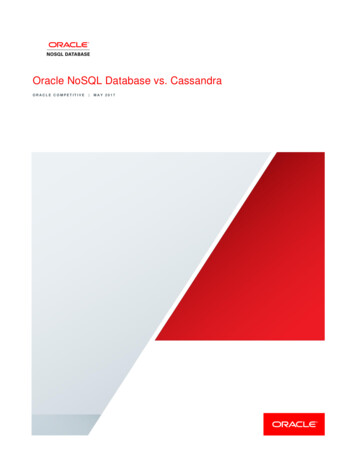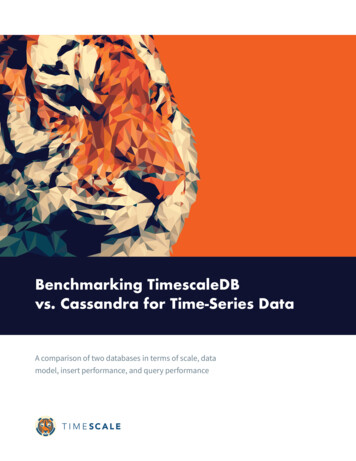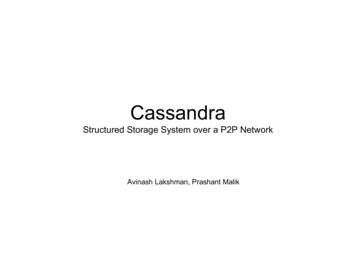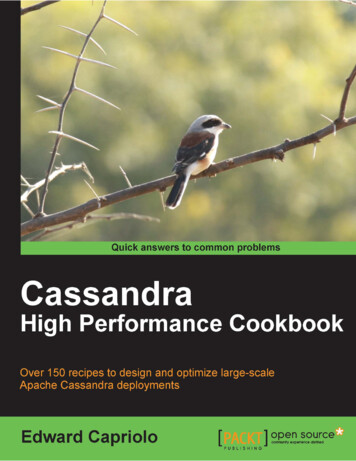
Transcription
Cassandra HighPerformanceCookbookOver 150 recipes to design and optimize large-scaleApache Cassandra deploymentsEdward CaprioloBIRMINGHAM - MUMBAI
Cassandra High Performance CookbookCopyright 2011 Packt PublishingAll rights reserved. No part of this book may be reproduced, stored in a retrieval system,or transmitted in any form or by any means, without the prior written permission of thepublisher, except in the case of brief quotations embedded in critical articles or reviews.Every effort has been made in the preparation of this book to ensure the accuracy of theinformation presented. However, the information contained in this book is sold withoutwarranty, either express or implied. Neither the author, nor Packt Publishing, and itsdealers and distributors will be held liable for any damages caused or alleged to becaused directly or indirectly by this book.Packt Publishing has endeavored to provide trademark information about all of thecompanies and products mentioned in this book by the appropriate use of capitals.However, Packt Publishing cannot guarantee the accuracy of this information.First published: July 2011Production Reference: 2070711Published by Packt Publishing Ltd.32 Lincoln RoadOltonBirmingham, B27 6PA, UK.ISBN 978-1-849515-12-2www.packtpub.comCover Image by Rakesh Shejwal (shejwal.rakesh@gmail.com)
CreditsAuthorEdward CaprioloReviewersVineet DanielProject CoordinatorMichelle QuadrosProofreaderJonathan ToddMatthew TovbinSeth LongJing SongAcquisition EditorDilip VenkateshDevelopment EditorRoger D'souzaTechnical EditorsIndexersHemangini BariTejal DaruwaleGraphicsNilesh MohiteProduction CoordinatorsAparna BhagatArvindkumar GuptaPrashant MachaGauri IyerManasi PoonthottamPooja PandeCover WorkAparna BhagatArvindkumar Gupta
About the AuthorEdward Capriolo is a member of the Apache Software Foundation and a committerfor the Hadoop-Hive project. He has experience as a developer as well Linux and networkadministrator and enjoys the rich world of Open Source software.Edward Capriolo is currently working as a System Administrator at Media6degreeswhere he designs and maintains distributed data storage systems for the Internetadvertising industry.To Stacey, my wife and best friend. To my parents, grandparents, andfamily. To friends who have supported me through many endeavors. To myeducators and employers who gave me the tools.To those who have contributed to Cassandra, including (but not limitedto) Jonathon Ellis, Brandon Williams, Jake Luciani, and others who havedeveloped an amazing project to learn and write about. Also deserving ofrecognition is the amazing community, including (but not limited to) RobertColi (my Cassandra sensei) and Jeremy Hanna. Special thanks to MattLandolf, Mubarak Seyed, Tyler Hobbs, and Eric Tamme who contributed theknowledge and free time to add to the content of the book.To the team at Packt Publishing. They did an excellent job by beautifullyredrafting my crude drawings, fixing my grammatical errors, and reviewingand suggesting content. The book got better with every new person whobecame involved.
About the ReviewersVineet Daniel is a Systems Architect and has worked at various startups and managedhigh traffic web applications. He has over eight years of experience in Softwaredevelopment, managing servers/cloud, and team. The experience has made him alearned individual in technologies like optimization, high-availability, and scalability. Heloves to use Linux commands and has a never ending appetite for penetration testing.Find him on www.vineetdaniel.me, @vineetdaniel.This is for my Parents, brother, Annie, and two wonderful kids in my life Anaand Aman for encouraging me to go ahead with the task. I would like tothank the team at Packt publishing especially Michelle for guiding me andproviding me with this wonderful opportunity to work with Packt Publishing.Matthew Tovbin received a BSc degree in computer science from the HadassahAcademic College, Jerusalem, Israel in 2005. He has been a software engineer inIntelligence Corps, Israel Defense Force (IDF), 2005-2008, working on a variety of militaryIT systems, and later a software engineer and a team leader in web-based startup namedAnyClip, making a dream of "Find any moment from any film, instantly" to come true.Currently Matthew is an MSc student in the Department of Computer Science, HadassahAcademic College and a software engineer of data infrastructure at Conduit.His experience covers aspects of the architecture, design, and development of highperformance distributed web and data analysis systems. His background includes a widerange of programming languages (including Java and C#), search engines (includingLucene), databases, and NoSQL distributed data stores.Matthew's research interests include search engines, distributed computing, imageprocessing, computer vision, and machine learning.I would like to thank my beloved girlfriend, Luba, for her thoughtful feedbackand support, during the review process of this book.
Jing Song has been working in the IT industry as an engineer for more than 12 yearsafter she graduated school. She enjoys solving problems and learning about newtechnologies in computer science space. Her interests and experiences lie acrossmultiple tiers, from web frontend GUI to middleware, from middleware to backend SQLRDBMS and NoSQL data storage. In the last five years, she has mainly focused on theenterprise application performance and cloud computing areas.Jing currently works for Apple as a tech lead with the Enterprise Technology Servicegroup, leading various Java applications from design, to implementation, to performancetuning. She was one of the contributors to the internal private cloud application last year.Her team has POC on most of the NoSQL candidates, for example, Cassandra, CouchDB,MongoDB, Redis, Voldeomort, MemCache, as well as EC2, EMC atmos, and so on.
www.PacktPub.comSupport files, eBooks, discount offers and moreYou might want to visit www.PacktPub.com for support files and downloads related toyour book.Did you know that Packt offers eBook versions of every book published, with PDF andePub files available? You can upgrade to the eBook version at www.PacktPub.com andas a print book customer, you are entitled to a discount on the eBook copy. Get in touchwith us at service@packtpub.com for more details.At www.PacktPub.com, you can also read a collection of free technical articles, sign upfor a range of free newsletters and receive exclusive discounts and offers on Packt booksand eBooks.http://PacktLib.PacktPub.comDo you need instant solutions to your IT questions? PacktLib is Packt's online digital booklibrary. Here, you can access, read and search across Packt's entire library of books.Why Subscribe?ffFully searchable across every book published by PacktffCopy & paste, print and bookmark contentffOn demand and accessible via web browserFree Access for Packt account holdersIf you have an account with Packt at www.PacktPub.com, you can use this to accessPacktLib today and view nine entirely free books. Simply use your login credentials forimmediate access.
Table of ContentsPrefaceChapter 1: Getting StartedIntroductionA simple single node Cassandra installationReading and writing test data using the command-line interfaceRunning multiple instances on a single machineScripting a multiple instance installationSetting up a build and test environment for tasks in this bookRunning in the foreground with full debuggingCalculating ideal Initial Tokens for use with Random PartitionerChoosing Initial Tokens for use with Partitioners that preserve orderingInsight into Cassandra with JConsoleConnecting with JConsole over a SOCKS proxyConnecting to Cassandra with Java and ThriftChapter 2: The Command-line InterfaceConnecting to Cassandra with the CLICreating a keyspace from the CLICreating a column family with the CLIDescribing a keyspaceWriting data with the CLIReading data with the CLIDeleting rows and columns from the CLIListing and paginating all rows in a column familyDropping a keyspace or a column familyCLI operations with super columnsUsing the assume keyword to decode column names or column valuesSupplying time to live information when inserting 7383940
Table of ContentsUsing built-in CLI functionsUsing column metadata and comparators for type enforcementChanging the consistency level of the CLIGetting help from the CLILoading CLI statements from a file4142434445Chapter 3: Application Programmer Interface47Chapter 4: Performance Tuning77IntroductionConnecting to a Cassandra serverCreating a keyspace and column family from the clientUsing MultiGet to limit round trips and overheadWriting unit tests with an embedded Cassandra serverCleaning up data directories before unit testsGenerating Thrift bindings for other languages (C , PHP, and others)Using the Cassandra Storage Proxy "Fat Client"Using range scans to find and remove old dataIterating all the columns of a large keySlicing columns in reverseBatch mutations to improve insert performance and code robustnessUsing TTL to create columns with self-deletion timesWorking with secondary indexesIntroductionChoosing an operating system and distributionChoosing a Java Virtual MachineUsing a dedicated Commit Log diskChoosing a high performing RAID levelFile system optimization for hard disk performanceBoosting read performance with the Key CacheBoosting read performance with the Row CacheDisabling Swap Memory for predictable performanceStopping Cassandra from using swap without disabling it system-wideEnabling Memory Mapped Disk modesTuning Memtables for write-heavy workloadsSaving memory on 64 bit architectures with compressed pointersTuning concurrent readers and writers for throughputSetting compaction thresholdsGarbage collection tuning to avoid JVM pausesRaising the open file limit to deal with many clientsIncreasing performance by scaling 898990929294959798
Table of ContentsChapter 5: Consistency, Availability, and Partition Tolerance withCassandraIntroductionWorking with the formula for strong consistencySupplying the timestamp value with write requestsDisabling the hinted handoff mechanismAdjusting read repair chance for less intensive data readsConfirming schema agreement across the clusterAdjusting replication factor to work with quorumUsing write consistency ONE, read consistency ONE for lowlatency operationsUsing write consistency QUORUM, read consistency QUORUM forstrong consistencyMixing levels write consistency QUORUM, read consistency ONEChoosing consistency over availability consistency ALLChoosing availability over consistency with write consistency ANYDemonstrating how consistency is not a lock or a transactionChapter 6: Schema DesignIntroductionSaving disk space by using small column namesSerializing data into large columns for smaller index sizesStoring time series data effectivelyUsing Super Columns for nested mapsUsing a lower Replication Factor for disk space saving and performanceenhancementsHybrid Random Partitioner using Order Preserving PartitionerStoring large objectsUsing Cassandra for distributed cachingStoring large or infrequently accessed data in a separate column familyStoring and searching edge graph data in CassandraDeveloping secondary data orderings or indexesChapter 7: AdministrationDefining seed nodes for Gossip CommunicationNodetool Move: Moving a node to a specific ring locationNodetool Remove: Removing a downed nodeNodetool Decommission: Removing a live nodeJoining nodes quickly with auto bootstrap set to falseGenerating SSH keys for password-less interactionCopying the data directory to new hardwareA node join using external data copy 160161162164165iii
Table of ContentsNodetool Repair: When to use anti-entropy repairNodetool Drain: Stable files on upgradeLowering gc grace for faster tombstone cleanupScheduling Major CompactionUsing nodetool snapshot for backupsClearing snapshots with nodetool clearsnapshotRestoring from a snapshotExporting data to JSON with sstable2jsonNodetool cleanup: Removing excess dataNodetool Compact: Defragment data and remove deleted data from diskChapter 8: Multiple Datacenter DeploymentsChanging debugging to determine where read operations are being routedUsing IPTables to simulate complex network scenarios in a localenvironmentChoosing IP addresses to work with RackInferringSnitchScripting a multiple datacenter installationDetermining natural endpoints, datacenter, and rack for a given keyManually specifying Rack and Datacenter configuration with a propertyfile snitchTroubleshooting dynamic snitch using JConsoleQuorum operations in multi-datacenter environmentsUsing traceroute to troubleshoot latency between network devicesEnsuring bandwidth between switches in multiple rack environmentsIncreasing rpc timeout for dealing with latency across datacentersChanging consistency level from the CLI to test various consistencylevels with multiple datacenter deploymentsUsing the consistency levels TWO and THREECalculating Ideal Initial Tokens for use with Network Topology Strategyand Random PartitionerChapter 9: Coding and InternalsIntroductionInstalling common development toolsBuilding Cassandra from sourceCreating your own type by sub classing abstract typeUsing the validation to check data on insertionCommunicating with the Cassandra developers and users through IRCand e-mailGenerating a diff using subversion's diff featureApplying a diff using the patch 04206207208
Table of ContentsUsing strings and od to quickly search through data filesCustomizing the sstable2json export utilityConfigure index interval ratio for lower memory usageIncreasing phi convict threshold for less reliable networksUsing the Cassandra maven plugin209210212213214Chapter 10: Libraries and Applications217Chapter 11: Hadoop and Cassandra237IntroductionBuilding the contrib stress tool for benchmarkingInserting and reading data with the stress toolRunning the Yahoo! Cloud Serving BenchmarkHector, a high-level client for CassandraDoing batch mutations with HectorCassandra with Java Persistence Architecture (JPA)Setting up Solandra for full text indexing with a Cassandra backendSetting up Zookeeper to support Cages for transactional lockingUsing Cages to implement an atomic read and setUsing Groovandra as a CLI alternativeSearchable log storage with LogsandraIntroductionA pseudo-distributed Hadoop setupA Map-only program that reads from Cassandra using theColumnFamilyInputFormatA Map-only program that writes to Cassandra using theCassandraOutputFormatUsing MapReduce to do grouping andcounting with Cassandra input and outputSetting up Hive with Cassandra Storage Handler supportDefining a Hive table over a Cassandra Column FamilyJoining two Column Families with HiveGrouping and counting column values with HiveCo-locating Hadoop Task Trackers on Cassandra nodesSetting up a "Shadow" data center for running only MapReduce jobsSetting up DataStax Brisk the combined stack of Cassandra, Hadoop,and HiveChapter 12: Collecting and Analyzing Performance StatisticsFinding bottlenecks with nodetool tpstatsUsing nodetool cfstats to retrieve column family statisticsMonitoring CPU utilizationAdding read/write graphs to find active column 242246248250251253254255257258261262263264266v
Table of ContentsUsing Memtable graphs to profile when and why they flushGraphing SSTable countMonitoring disk utilization and having a performance baselineMonitoring compaction by graphing its activityUsing nodetool compaction stats to check the progress of compactionGraphing column family statistics to track average/max row sizesUsing latency graphs to profile time to seek keysTracking the physical disk size of each column family over timeUsing nodetool cfhistograms to see the distribution of query latenciesTracking open networking connections267268269271272273274275276277Chapter 13: Monitoring Cassandra Servers279Index297IntroductionForwarding Log4j logs to a central severUsing top to understand overall performanceUsing iostat to monitor current disk performanceUsing sar to review performance over timeUsing JMXTerm to access Cassandra JMXMonitoring the garbage collection eventsUsing tpstats to find bottlenecksCreating a Nagios Check Script for CassandraKeep an eye out for large rows with compaction limitsReviewing network traffic with IPTrafKeep on the lookout for dropped messagesInspecting column families for dangerous 5
PrefaceApache Cassandra is a fault-tolerant, distributed data store which offers linear scalabilityallowing it to be a storage platform for large high volume websites.This book provides detailed recipes that describe how to use the features of Cassandra andimprove its performance. Recipes cover topics ranging from setting up Cassandra for the firsttime to complex multiple data center installations. The recipe format presents the informationin a concise actionable form.The book describes in detail how features of Cassandra can be tuned and what the possibleeffects of tuning can be. Recipes include how to access data stored in Cassandra and usethird party tools to help you out. The book also describes how to monitor and do capacityplanning to ensure it is performing at a high level. Towards the end, it takes you through theuse of libraries and third-party applications with Cassandra and Cassandra integrationwith Hadoop.What this book coversChapter 1, Getting Started: The recipes in this chapter provide a whirlwind tour of Cassandra.Setup recipes demonstrate how to download and install Cassandra as a single instance orsimulating multiple instance clusters. Trouble-shooting recipes show how to run Cassandrawith more debugging information and how to use management tools. Also includedare recipes for end users which connect with the command like interface and setup anenvironment to build code to access Cassandra.Chapter 2, Command-line Interface: This chapter provides recipes on using Cassandra'scommand line interface. Recipes cover how the CLI is used to make changes to the metadatasuch as key spaces, column families, and cache settings. Additionally recipes show how touse the CLI to set, get and scan data.Chapter 3, Application Programmer Interface: Cassandra provides an application programmerinterface for programs to insert and access data. The chapter has recipes for doing commonoperations like inserting fetching, deleting, and range scanning data. Also covered in thischapter are recipes for batch mutate and multi-get which are useful in batch programs.
PrefaceChapter 4, Performance Tuning: Many configuration knobs and tunable settings existfor Cassandra. Additionally hardware choices and operating system level tuning effectperformance. The recipes in this chapter show configuration options and how changingthem optimizes performance.Chapter 5, Consistency, Availability, and Partition Tolerance with Cassandra: Cassandra isdesigned from the ground up to store and replicate data across multiple nodes. This chapterhas recipes that utilize tunable consistency levels and configure features like read repair.These recipes demonstrate how to use features of Cassandra that make available even inthe case of failures or network partitions.Chapter 6, Schema Design: The Cassandra data model is designed for storing large amountsof data across many nodes. This chapter has recipes showing how common storagechallenges can be satisfied using Cassandra. Recipes include techniques for serializing data,storing large objects, time series, normalized, and de-normalized data.Chapter 7, Administration and Cluster Management: Cassandra allows nodes to be added andremove from the cluster without downtime. This chapter contains recipes for adding, moving,and removing nodes as well as administrative techniques for backing up and restoring data.Also covered administrative techniques such as backing up or restoring data.Chapter 8, Multiple Datacenter Deployments: Cassandra is designed to work both whennodes are deployed in a local area network and when nodes are separated by largergeographical distances such as a wide area network. The recipes in this chapter show howto configure and use features that control and optimize how Cassandra works in multipledatacenter environments.Chapter 9, Coding and Internals: This chapter covers programming recipes that go beyond thetypical application programmer interface, including building Cassandra from source, creatingcustom types for use with Cassandra, and modifying tools like the JSON export tools.Chapter 10, Third-party Libraries and Applications: A variety of libraries and applications existfor Cassandra. This chapter introduces tools that make coding easier such as the high-levelclient Hector, ot the object mapping tool Kundera. Recipes also show how to setup and useapplications built on top of Cassandra such as the full text search engine solandra.Chapter 11, Hadoop and Cassanda: Hadoop is a distributed file system, HDFS that provideshigh throughput and redundant storage and MapReduce, a software framework for distributedprocessing of large data sets on compute clusters. This chapter provides recipes with tips onsetting up Hadoop and Cassandra both individually and on shared hardware. Recipes showhow to use Cassandra as the input or output of map reduce jobs, as well as common taskslike counting or joining data that can be done with Cassandra data inside Hadoop.2
PrefaceChapter 12, Collecting and Analyzing Statistics: This chapter covers techniques for collectingperformance data from the Cassandra and the operating system. Recipes collect anddisplay performance data and how to interpret that data and use the information tuneCassandra servers.Chapter 13, Monitoring: The monitoring chapter has recipes which show how to install anduse tools to help understand the performance of Cassandra. Recipes include how to forwardlog events to a central server for aggregation. Othere recipes show how to monitor logs fordangerous conditions.What you need for this bookTo run the examples in this book the following software will be required:ffJava SE Development Kit 1.6.0 , 6u24 recommendedffApache Cassandra 0.7.0 , 7.5 recommendedffApache Ant 1.6.8 ffSubversion Client 1.6 ffMaven 3.0.3 Additionally the following tools are helpful, but are not strictly required:ffApache Thrift, latest stable release recommendedffApache Hadoop 0.20.0 ,0.20.2 recommended (needed for Hadoop Chapter)ffApache Hive 0.7.0 , 0.7.0 recommended (needed for Hadoop Chapter)ffApache Zookeeper 3.3.0 , 3.3.3 recommended (needed 1 for locking recipe)Who this book is forThis book is designed for administrators, developers, and data architects who are interestedin Apache Cassandra for redundant, highly performing, and scalable data storage. Typicallythese users should have experience working with a database technology, multiple nodecomputer clusters, and high availability solutions.ConventionsIn this book, you will find a number of styles of text that distinguish between different kinds ofinformation. Here are some examples of these styles, and an explanation of their meaning.Code words in text are shown as follows: "Edit the configuration file conf/cassandra.yamlto set where commit logs will be stored."3
PrefaceA block of code is set as follows:package hpcas.c03;import hpcas.c03.*;import java.util.List;import org.apache.cassandra.thrift.*;When we wish to draw your attention to a particular part of a code block, the relevant lines oritems are set in bold: path id "hpcas.test.classpath" pathelement location " {test.build}"/ pathelement location " {test.conf}" / path refid "hpcas.classpath"/ /path Any command-line input or output is written as follows: ant g TestTests run: 1, Failures: 0, Errors: 0, Time elapsed: 0.42 secRunning hpcas.c05.EmbeddedCassandraTestAll tests completeTests run: 1, Failures: 0, Errors: 0, Time elapsed: 3.26 secNew terms and important words are shown in bold. Words that you see on the screen, inmenus or dialog boxes for example, appear in the text like this: "Click on the attributes andthe Scores information will appear in the right panel."Warnings or important notes appear in a box like this.Tips and tricks appear like this.Reader feedbackFeedback from our readers is always welcome. Let us know what you think about this book—what you liked or may have disliked. Reader feedback is important for us to develop titles thatyou really get the most out of.To send us general feedback, simply send an e-mail to feedback@packtpub.com, andmention the book title via the subject of your message.4
PrefaceIf there is a book that you need and would like to see us publish, please send us a note in theSUGGEST A TITLE form on www.packtpub.com or e-mail suggest@packtpub.com.If there is a topic that you have expertise in and you are interested in either writing orcontributing to a book, see our author guide on www.packtpub.com/authors.Customer supportNow that you are the proud owner of a Packt book, we have a number of things to help you toget the most from your purchase.Downloading the example code for this bookYou can download the example code files for all Packt books you have purchased from youraccount at http://www.PacktPub.com. If you purchased this book elsewhere, you canvisit http://www.PacktPub.com/support and register to have the files e-mailed directlyto you.ErrataAlthough we have taken every care to ensure the accuracy of our content, mistakes do happen.If you find a mistake in one of our books—maybe a mistake in the text or the code—we would begrateful if you would report this to us. By doing so, you can save other readers from frustrationand help us improve subsequent versions of this book. If you find any errata, please report themby visiting http://www.packtpub.com/support, selecting your book, clicking on the erratasubmission form link, and entering the details of your errata. Once your errata are verified, yoursubmission will be accepted and the errata will be uploaded on our website, or added to anylist of existing errata, under the Errata section of that title. Any existing errata can be viewed byselecting your title from http://www.packtpub.com/support.PiracyPiracy of copyright material on the Internet is an ongoing problem across all media. At Packt,we take the protection of our copyright and licenses very seriously. If you come across anyillegal copies of our works, in any form, on the Internet, please provide us with the locationaddress or website name immediately so that we can pursue a remedy.Please contact us at copyright@packtpub.com with a link to the suspected pirated material.We appreciate your help in protecting our authors, and our ability to bring you valuable content.QuestionsYou can contact us at questions@packtpub.com if you are having a problem with anyaspect of the book, and we will do our best to address it.5
1Getting StartedIn this chapter, you will learn the following recipes:ff A simple single node Cassandra installationff Reading and writing test data using the command-line interfaceff Running multiple instances on a single machineff Scripting a multiple instance installationff Setting up a build and test environment for tasks in this bookff Running the server in the foreground with full debuggingff Calculating ideal Initial Tokens for use with Random Partitionerff Choosing Initial Tokens for use with Order Preserving Partitionersff Connecting to Cassandra with JConsoleff Using JConsole to connect over a SOCKS proxyff Connecting to Cassandra with Java and ThriftIntroductionThe Apache Cassandra Project develops a highly scalable second-generation distributeddatabase, bringing together a fully distributed design and a ColumnFamily-based data model.The chapter contains recipes that allow users to hit the ground running with Cassandra.We show several recipes to set up Cassandra. These include cursory explanations of thekey configuration files. It also contains recipes for connecting to Cassandra and executingcommands both from the application programmer interface and the command-line interface.Also described are the Java profiling tools such as JConsole. The recipes in this chapter shouldhelp the user understand the basics of running and working with Cassandra.
Getting StartedA simple single node Cassandra installationCassandra is a highly scalable distributed database. While it is designed to run on multipleproduction class servers, it can be installed on desktop computers for functional testing andexperimentation. This recipe shows how to set up a single instance of Cassandra.Getting readyVisit http://cassandra.apache.org in your web browser and find a link to thelatest binary release. New releases happen often. For reference, this recipe will assumeapache-cassandra-0.7.2-bin.tar.gz was the name of the downloaded file.How to do it.1. Download a binary version of Cassandra: mkdir home/downloads cd home/downloads wget url from getting ready /apache-cassandra-0.7.2-bin.tar.gz2. Choose a base directory that the user will run as he has read and write access to:Default Cassandra storage locationsCassandra defaults to wanting to save data in /var/lib/cassandraand logs in /var/log/cassandra. These locations will likely not existand will require root-level privileges to create. To avoid permission issues,carry out the installation in user-writable directories.3. Create a cassandra directory in your home directory. Inside the cassandradirectory, create commitlog, log, saved caches, and data subd
Cassandra High . Performance Cookbook. Over 150 recipes to design and optimize large-scale . Apache Cassandra deployments. Edward Capriolo. BIRMINGHAM - MUMBAI

